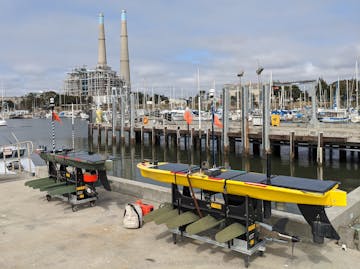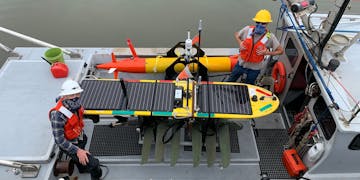Decades of developing tools to remotely study the ocean truly paid off in 2020 when the COVID-19 pandemic put a stop to most traditional seagoing research. At the same time, the institute made major adjustments to get ships back out to sea as quickly as possible.
When the imminent threat of COVID-19 became clear in March, MBARI was forced to swiftly suspend all seagoing operations. Unexpectedly terminating cruise plans that were more than a year in the making was a major shock to many research and engineering programs. Some research teams require being at sea during particular times of year, year-over-year, to make specific observations. Canceling just one cruise can result in the loss of irreplaceable data and delay a project by a year or more. Despite all the obvious downsides that suspending ship operations posed, it was absolutely necessary given the circumstances. And while that decision was an easy one to make, it ultimately paled in comparison to the challenge of restarting operations months later.

Under the direction of Mike Kelly, the Division of Marine Operations put in substantial effort to get the ships back to sea. Ships, like all machines, work best when they are used regularly and maintained in top condition. Tying a vessel dockside and letting it sit quietly for an extended period is not good for a ship. Recovering from a hard shutdown requires time to restart and test all systems, and ensure that everything is working properly—a time-consuming process. By chance, the Western Flyer also needed major dry-dock servicing at a shipyard during the shutdown. This shipyard happened to be located in an area where COVID-19 infection rates were high. So, getting the ships back in operational status after the initial shutdown was a major undertaking, but other hurdles remained.
Frequent handwashing and use of face coverings were easy protocols to enact. But social distancing is not practical, and often impossible, when working on a ship at sea. Spaces are confined, the crew and science parties often work shoulder to shoulder for hours on end. Accommodating those realities during the pandemic demanded new policies and procedures to reduce potential viral spread among seagoing personnel.
Ultimately MBARI settled on a three-pronged approach. First, as a private ship operator, MBARI was able to restrict ship access to employees only. With fewer people accessing the ships, it was possible to create social cohorts that limited interpersonal contacts, which was much more challenging for other academic ship operators that serve multiple institutions. Second, a new telepresence capability was created so that members of the science party who had to remain onshore could participate virtually. Lastly, a routine testing protocol was devised for screening cruise participants for possible COVID-19 infections.
Together with a detailed return-to-sea policy that established well-defined guidelines and procedures, those actions allowed MBARI to resume ship operations safely even as the pandemic persisted.
Despite all of those measures, and the professionalism and interpersonal considerations required to implement them, it became necessary to suspend ship operations once again in December as an unprecedented wave of COVID infections overtook California.
In addition to the adjustments in at-sea operations during the year, some science programs continued to rely on a range of robotic and autonomous instruments to continue the work without the risk of spreading infections.

Masking up and eating alone on the Western Flyer
An ambitious expedition to Northern California and Southern Oregon on the R/V Western Flyer in September focused on research into the earthquake recurrence interval along the Cascadia Subduction Zone. Despite the quiet seismic behavior of this location over the last 300 years, mega-earthquakes of enormous destructive power have and will happen in this region. Sediment deposits from synchronous turbidity flows in submarine canyons along the continental margin are believed to be indicators of past major earthquake activity. This cruise intended to find turbidite deposits in multiple canyon systems and evaluate their synchronicity and behavior regionally. This information is fundamental for improving the probabilistic hazard assessments associated with future earthquakes.
Chief Scientist Charlie Paull reduced his usual science team of 11 to just himself and three others, leaving the team quite shorthanded when processing samples. For the crew and science team aboard the Western Flyer, pandemic safety protocols meant social distancing, wearing masks for 18 hours a day, and eating in quasi-isolation instead of enjoying the usual camaraderie at mealtime.
Remotely operated vehicle operations were conducted on 17 days, with one fewer pilot than the normal crew. The shipboard party stayed on the ship during an overnight port stop in Eureka, California, to resupply and drop off core samples, making this the longest consecutive-day cruise the Western Flyer has conducted.
Despite the limited number of scientists and pilots and the constraints imposed by the safety procedures related to COVID-19, the cruise was extremely successful as measured by the number of samples collected: 387 push cores and 167 vibracores. Paull said he was very pleased and proud of how this cruise proceeded, especially considering the COVID pandemic.
Creating a virtual presence for the science team
During Paull’s three-week cruise, Senior Research Technician Eve Lundsten and Electrical Engineer Eric Martin stood by onshore, providing remote assistance to the at-sea team and hosting the rest of the science party on the new telepresence system. The system kept the team in communication, allowing for questions or requests to take particular samples from the scientists who remained onshore. At the end of each dive, the entire team discussed what they had seen and set priorities for the next dives.
This new system was used on four Western Flyer expeditions and 10 single-day cruises on the R/V Rachel Carson. A total of 56 researchers participated in MBARI expeditions via this new virtual presence, including colleagues from around the world—France, Chile, England, and, of course, the U.S.—who might have traveled to join in person had the world not been locked down from travel.
Relying on autonomous tools
Two of MBARI’s large research programs were able to continue making progress collecting data and samples, despite the pandemic because they rely heavily on robotic vehicles and autonomous instruments. MBARI has been developing these tools for years to enable a persistent presence in the ocean. Operating during a pandemic was never a stated reason for creating robotic instruments, but it turned out to be a perfect match.

Once in the water, these two Wave Gliders, equipped with echosounders, would zigzag in Monterey Bay to locate fish and other animals in the water below. Image: Chris Wahl © 2020 MBARI
The complex Controlled, Agile, and Novel Ocean Network (CANON) experiment, under the leadership of Senior Scientist Francisco Chavez, has involved orchestrating several collaborative institutions each year, sending multiple ships to sea and employing a range of robotic vehicles and autonomous instruments, often simultaneously, to gather data and physical samples in Monterey Bay. In 2020, the seagoing aspect of the experiment was pared back, and the science, engineering, and marine operations teams focused more heavily on a remote presence in the ocean.
They collected data and physical samples with autonomous instruments and vehicles monitored by scientists onshore, socially distanced. The goal of the experiment was to study large groups of anchovies and other animals that congregate in and around Monterey Canyon. To figure out where and when these animals gather within the canyon, researchers from MBARI and the National Oceanic and Atmospheric Administration (NOAA) combined two very different technologies—high-resolution echosounders and environmental DNA (eDNA).

NOAA uses these data to assess fish stocks. While they often use net trawls and echosounders on ships to
map the distribution of fish, during CANON, they turned their attention instead to the echosounders mounted on robotic vehicles at the surface, and eDNA collected with underwater robots.
The increased use of autonomous vehicles and the Environmental Sample Processor (ESP) led to a corresponding increase in the number of samples.
“Having more samples is great for the science. And the samples can be stored in a freezer and preserved for years,” said Research Associate Katie Pitz, who was involved in planning the operation. “Analytical methods for eDNA are improving rapidly, so it’s nice to preserve some samples for later analysis in case a better technique comes along.”
The Summer 2020 CANON experiment was successful even though fewer people went to sea. “This mode of operation will increase dramatically in the future,” Chavez said. “Not only because of COVID, but because of the need for persistent and globally distributed observations of life in the sea.”
Another ongoing research effort relies on data from a large array of ocean floats, which continue to collect and transmit data, COVID or no COVID. MBARI Senior Scientist Ken Johnson, noted that the pandemic only underscored the point that remote instruments are incredibly valuable. Even as scientists are confined to their homes and ships remain at the dock, the array of floats continues to send data back regularly so that the shoreside team can monitor distant ocean health from the comfort of home.
